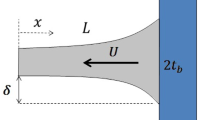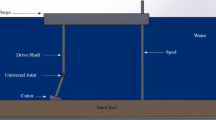Abstract
The objective of this study is to propose an improved model to evaluate the fatigue life of slender marine structures with high efficiency and accuracy. We establish two Weibull functions to represent the probability density function (PDF) of time-varying flow velocities and fatigue stress. Next, a modified Latin hypercube sampling method is developed to improve the efficiency by reducing the sampling number based on the characteristics of vortex-induced vibrations. In addition, we employ the response surface method to predict the dominant mode and select the truncation order. This method could make the calculation time of each stress amplitude within 0.1–4 s, which meets the requirement for efficiency. To further improve the calculation accuracy, the Strouhal number used in the wake oscillator model is considered to change with the reduced velocity by introducing a correction factor. Besides, the influence of the tension fluctuation from axial vibration on fatigue damage is taken into consideration. A good agreement is achieved in the comparison between the numerical and experimental results. Moreover, the improvement of the accuracy and the efficiency of the proposed model is validated. In the end, a parametric study is conducted to investigate the effect of flow PDF parameters on the fatigue life.















Similar content being viewed by others
References
Xu JH, Li GG, Horrillo JJ, Rongmin Y, Cao LH (2010) Calculation of maximum allowable free span length and safety assessment of the DFI-1 submarine pipeline. J Ocean Univ China 9(1):1–10
Sanaati B, Naomi K (2012) Vortex-induced vibration (VIV) dynamics of a tensioned flexible cylinder subjected to uniform cross-flow. J Mar Sci Technol 18(2):247–261
Tovo R (2000) A damage-based evaluation of probability density distribution for rain-flow ranges from random processes. Int J Fatigue 22(5):425–429
Mørk K, Fyrileiv O, Chezhian M, Nielsen FG, Søreide T (2003) Assessment of VIV induced fatigue in long free spanning pipelines. 22nd international conference Offshore Mech. Arctic Eng. Cancun, Mexico, OMAE, 2, 1–7
Yang B, Gao FP (2008) Flow-induced vibrations of a cylinder with two degrees of freedom near rigid plane boundary. Int J Offshore Polar Eng 18(4):302–307
Chen WM, Zhang LW, Li M (2009) Prediction of vortex-induced vibration of flexible riser using improved wake-oscillator model. Eng Mech 27:377–383
Passano E, Larsen CM, Wu J (2010) VIV of free spanning pipelines: comparison of response from semi-empirical code to model tests. 29th international conference Ocean, Offshore and Arctic Engineering, Shanghai, China
Gu JJ, Wang Y, Zhang Y, Duan ML, Levi C (2013) Analytical solution of mean top tension of long flexible riser in modeling vortex-induced vibrations. Appl Ocean Res 41:1–8
Trim AD, Braaten H, Lie H, Tognarelli MA (2005) Experimental investigation of vortex-induced vibration of long marine risers. J Fluids Struct 21(3):335–361
Thorsen MJ, Sævik S, Larsen CM (2015) Fatigue damage from time domain simulation of combined in-line and cross-flow vortex-induced vibrations. Mar Struct 41:200–222
Ying ML, Srinil N (2016) VIV fatigue reliability analysis of marine risers with uncertainties in the wake oscillator model. Eng Struct 106:96–108
Tsukada RI, Morooka CK (2016) A numerical procedure to calculate the VIV response of a catenary riser. Ocean Eng 122:145–161
Thorsen MJ, Sævik S, Larsen CM (2016) Time domain simulation of vortex-induced vibrations in stationary and oscillating flows. J Fluids Struct 61:1–19
Facchinetti ML, Langre ED, Biolley F (2004) Coupling of structure and wake oscillators in vortex-induced vibrations. J Fluids Struct 19(2):123–140
Mathelin L, Langre E (2005) Vortex-induced vibrations and waves under shear flow with a wake oscillator model. Eur J Mech B Fluids 24(4):478–490
Tognarelli M, Slocum S, Frank W, Campbell R (2004) VIV response of a long flexible cylinder in uniform and linearly shear currents. Offshore technology conference, Houston, USA
Huse E, Kleiven G, Nielsen F (1999) VIV-induced axial vibrations in deep sea risers. Offshore technology conference, Houston, Texas, USA
Hu YR, Li DQ, Chen BZ (2010) Fatigue and reliability analysis for ships and marine structures. Harbin Institute of Technology Press, Harbin, pp 45–62
DNV (2016) Fatigue design of offshore steel structures. DNVGL-RP-C203. Det Norske Veritas, Høvik
Helton JC, Davis FJ (2003) Latin hypercube sampling and the propagation of uncertainty in analyses of complex systems. Reliab Eng Syst Saf 81(1):23–69
DNV (2017) Free spanning pipelines. DNVGL-RP-F105. Det Norske Veritas, Høvik
Violettea R, Langrea ED, Szydlowski J (2007) Computation of vortex-induced vibrations of long structures using a wake oscillator model: comparison with DNS and experiments. Comput Struct 85(11):1134–1141
Blevins RD, Saunders H (1977) Flow-induced vibration. Van Nostrand Reinhold Co, New York
Xu J, Wang DS, Huang H, Duan ML, Gu JJ, An C (2017) A vortex-induced vibration model for the fatigue analysis of a marine drilling riser. Ships Offshore Struct 12(sup1):280–287
Huse E, Kleiven G, Nielsen F (1998) Large scale model testing of deep sea risers. Offshore technology conference, Houston, Texas
Song J, Lu L, Teng B, Park H, Tang G, Wu H (2011) Laboratory tests of vortex-induced vibrations of a long flexible riser pipe subjected to uniform flow. Ocean Eng 38:1308–1322
Liu QT (2003). The Research of the dynamic property and Fatigue damage of marine pipe span. Dalian University of Technology, Dalian
Wen BC, Liu SY, Chen ZP, Li H (2010) Theory of mechanical vibration and its applications. Higher Education Press, Beijing
Acknowledgements
The authors acknowledge gratefully financial support provided by the China National Key Research and Development Plan (Grant No. 2016YFC0303701), the National Natural Science Foundation of China (Grant No. 51409259), the Science Foundation of China University of Petroleum, Beijing (Grant No. C201602) for the financial support of this research.
Author information
Authors and Affiliations
Corresponding author
Appendix
Appendix
The solution of the y(z,t) in Eq. 14 can be written as [28]:
where \({\bar {\phi }_i}(z)\) is the mode function; \({\bar {y}_i}(t)\) is the weight function.
Next, the authors select the eigenvalue and propose eigenfunction expansion. The eigenvalue problem is chosen as:
where \({\phi _i}(z)\) is the eigenfunction of Eq. 24, which satisfies the orthogonality property.
The selection of eigenfunction is computed based on the auxiliary eigenvalue problem with the boundary condition satisfied. The eigenfunction could be written as:
where αi is the eigenvalue.
The eigenfunction problem allows the definition of the following integral transform pair:
where \({\tilde {\phi }_i}(z)=\frac{{{\phi _i}(z)}}{{N_{i}^{{1/2}}}}=\sqrt 2 {\phi _i}(z)\), \({N_i}=\int_{0}^{1} {\phi _{i}^{2}} {\text{d}}z\).
After establishing the integral transform pair for y(z,t), the dimensionless form of Eq. 14 is multiplied by \(\int_{0}^{1} {{{\tilde {\phi }}_i}} {\text{d}}z\), and then some mathematical manipulation is conducted. The modal analysis for Eq. 13 follows the same method by introducing another eigenfunction \({\mathop \Psi \limits^{\sim } _k}(z)\).
The new equation form after modal analysis is:
where the K is the truncation order, the coefficients matrices are given by the following expressions:
About this article
Cite this article
Xu, J., Jia, X., Duan, M. et al. An improved model for VIV fatigue life prediction of slender marine structures in time-varying flows. J Mar Sci Technol 24, 490–499 (2019). https://doi.org/10.1007/s00773-018-0569-8
Received:
Accepted:
Published:
Issue Date:
DOI: https://doi.org/10.1007/s00773-018-0569-8




